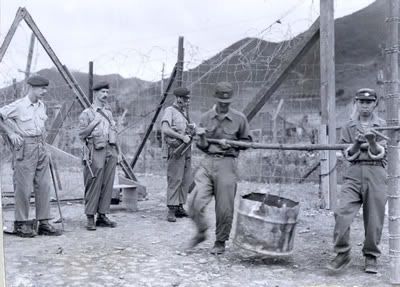
B Coy RCR deploys to Koje-do
by Charmion Chaplin-Thomas
Koje-do, Korea
May 23, 1952
In Tokchong, South Korea, Major E.L. Cohen and the men of Baker Company, 1st Battalion, The Royal Canadian Regiment board a train for Pusan with their weapons, radios and company stores stowed in a boxcar and several jeeps and light trucks lashed to a flatcar behind the locomotive. They are bound for Koje-do, an island off the southeast coast that the US Army converted into a prisoner-of-war camp, to help restore order after months of turmoil.
The Koje-do prison camp originally consisted of 32 compounds, each built to hold 700 to 1 200 men and guarded by South Korean and American military police and infantry. Construction began in January 1951, and the compounds were soon packed to five times their capacity. More compounds were built in the spaces between the original enclosures, leaving the compounds separated by a single layer of barbed-wire fence so the prisoners can communicate freely but the guards cannot watch the prisoners. Communist agitators control the prisoners, not only to frustrate the guards, but also to prevent the prisoners from defecting. The prisoners cannot leave the compounds without being shot by the guards, but the guards cannot enter the compounds without being attacked by the prisoners. In fact, a mass break-out is the least of UN Command’s worries at Koje-do; the intolerable prison camp is a huge propaganda prize for the Communists.
The situation at Koje-do became acutely dangerous when the UN negotiators at the armistice talks raised the possibility that the prisoners of war would be screened to identify those who do not wish to return to Communist territory; beatings and killings became commonplace in the compounds, and the prisoners ceased to bother hiding their weapons. The crisis peaked on May 6, when a hard-line group in Compound 76 kidnapped the camp commandant, Brigadier-General Francis T. Dodd, and forced him to sign a statement admitting to maltreatment and political oppression of prisoners. General Mark Clark, the UN force commander, ordered in US Army armour and infantry armed with flamethrowers and machine-guns to put down the prisoners’ revolt, and requested support from the other national contingents in the UN force. Maj Cohen’s company is matched with a company from the King’s Shropshire Light Infantry, and the Dutch and Greek contingents are also contributing a company each.
Baker Company arrives on Koje-do on May 24, and the next day the Canadians are introduced to BGen Haydon L. Boatner, the new camp commandant. After a few words of greeting, BGen Boatner tells the soldiers, “If you see somebody escaping and you’re going to shoot, then make sure you kill him, because the hospital’s full right now. …You would also be wise not to shoot a guy who is almost over the fence. Shoot the one who’s trying to stop him. The first one may want to come over to our side.”
The vastly augmented guard force clears out the compounds one by one, surrounding them with armoured fighting vehicles and forcing the prisoners out with flame-throwers if machine-guns and fists aren’t persuasive enough. In some compounds, the prisoners fight from trenches with pole-arms, knives and clubs, and one US soldier is killed and many more wounded in these battles. As soon as a compound is cleared, the buildings are burned to prevent prisoners from salvaging weapons from the wreckage. Each prisoner is stripped, photographed and fingerprinted before being moved into a new compound.
The Royals’ turn to clear a compound comes on June 13, at Compound 66. The wire is hung with banners denouncing the Canadians as “satellites of American imperialists”, and prisoners spent the night singing loudly and ostentatiously burning papers. At 10 a.m., the Royals roll up to the main gate with the Shropshires, and take up positions around the perimeter and in columns on either side of the main gate. The prisoners are instructed to come out of the compound, take off their clothes and board the waiting trucks, and the soldiers brace for a vicious battle. Much to everyone’s surprise, the prisoners follow the instructions to the letter, and in 10 minutes the compound is empty.
